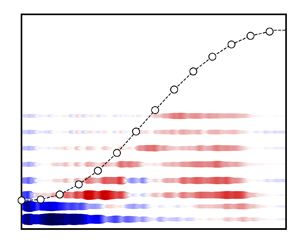Article contents
Polydispersity effect on dry and immersed granular collapses: an experimental study
Published online by Cambridge University Press: 21 March 2024
Abstract

The column collapse experiment is a simplified version of natural and industrial granular flows. In this set-up, a column built with grains collapses and spreads over a horizontal plane. Granular flows are often studied with a monodisperse distribution; however, this is not the case in natural granular flows where a variety of grain sizes, known as polydispersity, is a common feature. In this work, we study the effect of polydispersity, and of the inherent changes that polydispersity causes in the initial packing fraction, in dry and immersed columns. We show that dry columns are not significantly affected by polydispersity, reaching similar distances at similar times. In contrast, immersed columns are strongly affected by the polydispersity and packing fraction, and the collapse sequence is linked to changes of the basal pore fluid pressure  $P$. At the collapse initiation, negative changes of
$P$. At the collapse initiation, negative changes of  $P$ beneath the column produce a temporary increase of the column strength. The negative change of
$P$ beneath the column produce a temporary increase of the column strength. The negative change of  $P$ lasts longer in polydisperse columns than in monodisperse columns, delaying the collapse sequence. Conversely, during the column spreading, positive changes of
$P$ lasts longer in polydisperse columns than in monodisperse columns, delaying the collapse sequence. Conversely, during the column spreading, positive changes of  $P$ lead to a decrease of the shear strength. For polydisperse collapses, the excess of
$P$ lead to a decrease of the shear strength. For polydisperse collapses, the excess of  $P$ lasts longer, allowing the material to reach farther distances, compared with the collapses of monodisperse materials. Finally, we show that a mobility model that scales the final runout with the collapse kinetic energy remains true for different polydispersity levels in a three-dimensional configuration, capturing the scaling between the micro to macro controlling features.
$P$ lasts longer, allowing the material to reach farther distances, compared with the collapses of monodisperse materials. Finally, we show that a mobility model that scales the final runout with the collapse kinetic energy remains true for different polydispersity levels in a three-dimensional configuration, capturing the scaling between the micro to macro controlling features.
- Type
- JFM Papers
- Information
- Copyright
- © The Author(s), 2024. Published by Cambridge University Press
References
Polanía et al. supplementary movie 1
Polanía et al. supplementary movie 2
Polanía et al. supplementary movie 3
Polanía et al. supplementary movie 4
Polanía et al. supplementary movie 5
- 1
- Cited by





